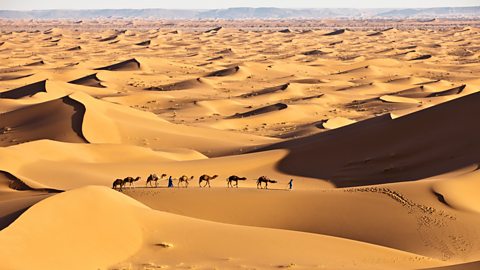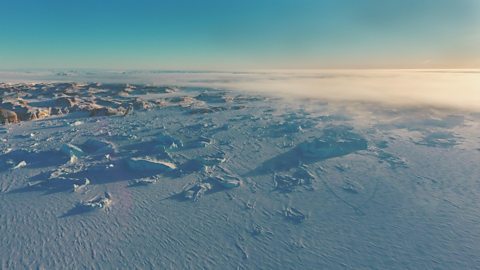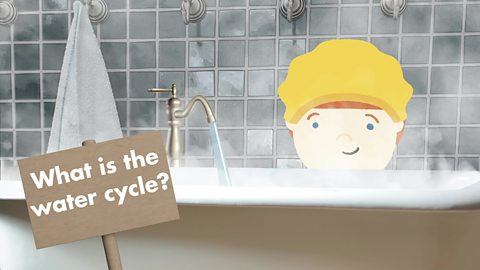What is humidity?
Have you ever felt hot and sticky in warm weather? That's because of humidity.
In this article you can learn:
- What humidity is
- The processes of condensation and evaporation
- Humidity around the world
- How to measure humidity
This resource is suitable for weather topics for primary school learners.
Video - What is humidity?
Watch this video to learn about humidity and the processes of condensation and evaporation.
Have you ever felt hot and sweaty even when you haven't done any exercise? That might be because of humidity.
But what is humidity?
Humidity is a measure of how much water there is in the air. Not liquid waterlike rain, invisible water in the form of a gas called water vapour.
Humidity is a measure of how much water there is in the air. Not liquid water like rain, invisible water in the form of a gas called water vapour.
Water is constantly evaporating into the air and turning into vapour. Some of it condenses back into liquid as clouds and rain. Some of it stays hanging in the air as vapour.
Air temperature has a big impact on humidity. Warmer air can hold much more water vapour. So it takes much more vapour to make warm air feel sticky and humid. So when the temperature goes up, the humidity comes down.
The other thing that affects humidity is how much water there is around.It’s much more humid after it has rained, or when you are near the sea or a loch, because there is more water to evaporate into the air. Even a garden pond can increase the humidity!
Different parts of the world have very different kinds of humidity.
Here in the Sahara Desert in Africa, there’s very low humidity. The air is hot and can hold a lot of vapour. But there aren’t any rivers or lakes to supply it. Because there is so little water vapour in the air, the humidity is low. Clouds don’t form so it doesn’t rain or snow and the ground is very dry. This means there aren’t a lot of plants, people or other living things because they all need water to survive.
But not all deserts are hot. Did you know that Antarctica is the largest desert on Earth? It’s so cold that the air wouldn’t need much vapour to become humid. But because it’s so cold, there is no liquid water to evaporate into the air. The humidity is extremely low - the air is very dry, there is little snowfall and only a few things can live here.
Where there is plenty of water vapour in the air there is more chance of life surviving. A good example would be a rainforest. And here in the Amazon it’s very humid! And you can see that there is lots of life here!
When it’s warm, our bodies sweat to cool us down, but if the air is already very humid, then it is less easy for the sweat to evaporate from our skin, so we can’t cool down as easily.
Next time you’re out and about and feeling hot and sweaty, just touch your head - and if it feels warm and sticky that’s probably because of the humidity!
Facts about humidity
Humidity is a measure of how much water there is in the air.
When water is in the air it's in the form of an invisible gas called water vapour.
If there's lots of water vapour in the air, this means the humidity will be high.
When we get hot, our bodies sweat to help cool us down. When it is humid there's already lots of water vapour in the air. That makes it more difficult for your sweat to evaporate into the air. So high humidity can leave you hot and sticky.
Discover more about sweat and how humans stay cool in hot weather here: How do humans maintain temperature and water balance?
Humidity across the planet
Learn about humidity in the Sahara, the Antarctic and rainforests in this slideshow.

Image caption, A hot and sticky summer's day
If you're in the park in summer and you feel hot and sticky, this is because the humidity levels are high.

Image caption, The Sahara - a hot, sandy desert
In the Sahara desert in Africa, humidity tends to be low as there are no lakes or rivers to supply water vapour. This lack of water means that not many things live in the desert.

Image caption, The Antarctic - a cold, icy desert
The Antarctic is also a desert. There's lots of water vapour because of the snow and ice, but because it's so cold there's no liquid water to evaporate into the air. So humidity is very low and very few things live in the Antarctic.

Image caption, The rainforest - a very humid place
In a rainforest, there's lot of sources of water vapour like rain, rivers and lakes. It can be very humid but all the sources of water are very good for life. So lots of animals live in rainforests.
1 of 4
How to measure humidity
Video - Measuring humidity
High humidity can make us feel hot and sticky.
With help from BBC Weather's Kawser Quamer, learn:
- How to measure humidity
- How we can measure humidity using a sling psychrometer
- How to test humidity using a sponge and a jug of water
KAWSER: It's really warm and sticky in the studio today. And you can see from the map, all the red colours and the high temperature showing how hot it is. Now often with heat, we get humidity. Humidity means the moisture in the air and is shown by percentages. But how do we measure it?
The air contains billions of tiny particles of water called vapour. Vapour is water that has turned from a liquid to a gas. We can feel it when there is so much that the air feels a bit sticky.
You can show there is water vapour in the air by breathing against a cold window. The water vapour in your breath will cool down and form as tiny drops of liquid water on the surface of the window.
The amount of water vapour in the air is known as humidity and it is measured as a percentage.
Imagine this sponge is the air around us. If the sponge is bone dry with no water in it, this is like having low humidity in the air. No water at all would be zero percent humidity. If you slowly add water to the sponge, it'll soak it up until it becomes full of water. When the sponge has soaked up all the water it can, it's reached 100% humidity.
The same thing happens when the air is full of water vapour. When the air can't hold any more water, this causes clouds to form resulting in rainy conditions.
PUPIL: We need to spin the sling psychrometer around.
PUPIL: For how long?
PUPIL: About thirty seconds.
KAWSER: Humidity can be measured using an instrument called a sling psychrometer. This has two separate thermometers. One called a dry bulb thermometer and the other a wet bulb thermometer. The wet bulb thermometer has a damp cloth around the bulb at the bottom of it. This measures the temperature that liquid water evaporates at when it turns into its gas state as water vapour.
PUPIL: The dry bulb is four degrees Celsius.
PUPIL: It looks like the wet bulb temperature is two degrees Celsius,
KAWSER: Take readings from both thermometers and subtract the wet bulb temperature from the dry bulb temperature. You then compare this to a relative humidity chart to check the humidity level.
PUPIL: The wet bulb temperature was two degrees Celsius.
PUPIL: And the dry bulb was four degrees Celsius. That's a difference of two degrees.
PUPIL: So what does the chart say?
PUPIL: The humidity was seventy percent.
KAWSER: Is it humid where you are today? And how would you know?

Key words about humidity
- water vapour - Water in the form of an invisible gas.
- condensation - When water vapour turns into a liquid.
- evaporation - When water turns into a gas.
- humidity - A measure of how much water vapour there is in the air.
Test your knowledge
Quiz
Challenge

Create your own humidity experiment.
You will need:
- A sponge
- A jug of water
- A tray or something to catch excess water
What to do:
- The sponge is like the air around us. A dry sponge with no water in it can be described as 0% humidity.
- If you add water to the sponge and it becomes so full it cannot take in any more water then it is at 100% humidity.
Watch the film above to learn more.
More on Weather
Find out more by working through a topic
- count9 of 24

- count10 of 24

- count11 of 24

- count12 of 24
